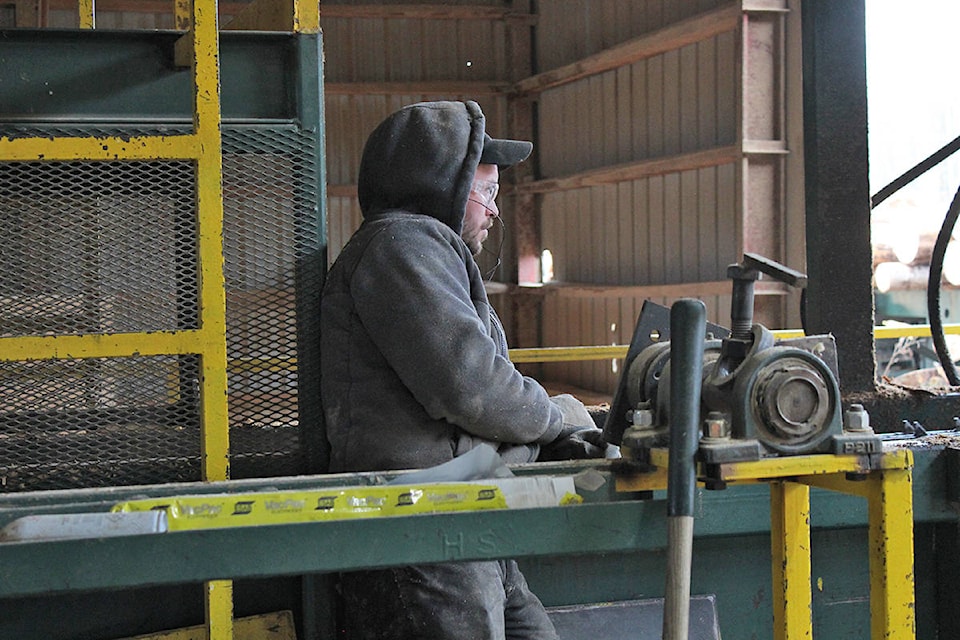A win-win-win scenario to solve a wood supply problem for Seaton Forest Products is being stymied by forestry regulations.
The small mill just west of Witset makes square cants out of low-grade timber, mostly for export to China where they are re-milled to make shipping crates, pallets and things of that nature.
The company has an allocation of 80,000 cubic metres a year, which would allow them to operate for 50 weeks employing 23 people, 75 per cent of whom are Indigenous.
However, due mainly to the unprecedented wetness of last season, the mill has only received 61,000 cubic metres.
Seaton co-owner Andy Thompson said the supply they have left will only carry them through approximately another five weeks meaning they will be forced to lay off their workers until the next logging season (approximately six to eight weeks).
READ MORE: Pinnacle Pellet makes noise reduction progress
Fortunately, there is a supply they could tap into. Pinnacle Pellet in Smithers has an overabundance of logs in its yard. Most of it is slash only suitable for pellet making, but enough is of the grade Seaton is looking for to keep them in business.
Pinnacle is willing to let Seaton sort through their woodpiles and buy what they have.
If they were to be allowed to make the company-to-company deal, there are other spin-off benefits. Seaton currently supplies Pinnacle with a significant amount of chipped wood for pellet making. The waste from the logs Pinnacle would supply would be shipped back to them in chipped form, meaning less chipping for Pinnacle, which has had issues with the pellet plant’s neighbours over noise.
Unfortunately, the Province’s Concurrent Residual Harvest System (CRHS) is proving to be a roadblock.
The purpose of this system is to “improve utilization of forest resources” by allowing business to business agreements between primary harvesters and secondary manufacturers. Wood that previously would have been burned in slash piles, can now be sold to companies like Pinnacle and Seaton.
READ MORE: Looking for alternatives to open fire burns
However, the CRHS does not allow loads of material to resorted and sold after transport from the primary harvester to the secondary manufacturer.
Seaton has sought help from the Ministry of Forests Lands and Natural Resources (FLNRO) and while sympathetic to the company’s plight, has so far not found a solution.
In an email to Seaton, Jevan Hanchard, FLNRO district manager confirmed what the two companies are seeking to do is simply not permitted.
“While the CRHS stratum may not work, if Pinnacle has BCTS (B.C. Timber Sales) or private volume (or non-CRHS sawlog or non-sawlog volume) then those would be available for re-sort,” he said.
But Pinnacle does not have the volume of non-CRHS wood Seaton needs, Thompson said.
Cullen said he is also sympathetic, noting Seaton ticks all the boxes for an operation that should be supported seeing as it provides local and Indigenous employment while diverting undesirable timber from slash burning.
However, he said it is not a simple matter of making an exception to a rule.
“My feeling is everyone is trying to figure it out, we haven’t got an answer yet, but no one’s losing hope and we’re all kind of pulling the same way,” he said. “The ministry staff have been really helpful, but when you run up against what seems to be a pretty significant piece of the policy then finding a workaround can be tricky.”
Cullen said his biggest concerns are implications related to Canada’s Softwood Lumber Agreement with the United States and has consulted with government lawyers who are reviewing the situation.
“The Americans are always on the lookout for anything would let them even pretend that it’s an illegal subsidy, which this is not, but that’s not stopped them in the past,” he said. “They will challenge just about anything and everything, so we’ve just got to keep an eye on it.”
Finally, he said, he doesn’t know yet if this may be a case where a policy is preventing something it may not have been intended to prevent, but revisiting it is a process with a very long timeline.
“Changing a policy, if possible doesn’t happen in a week, and while that may be true, or it might not, while relevant to this story it doesn’t help (Seaton).”
https://www.interior-news.com/local-news/looking-for-alternatives-to-open-fire-burns/
